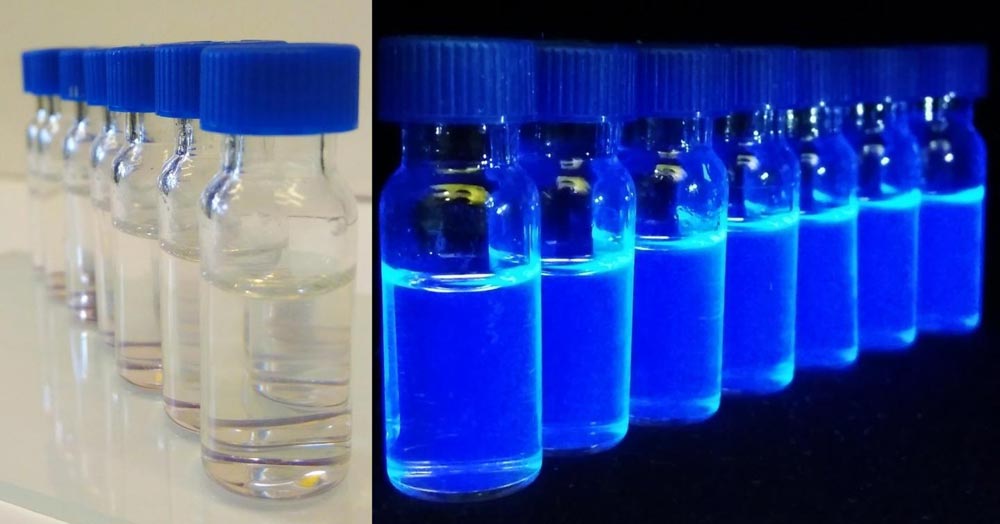

This is a photograph of solutions of synthesized thiophene derivatives in dioxane in daylight and irradiation with a UV lamp with an excitation wavelength of 380 nm.
Credit: Nataliya Belskaya, Professor, UrFU Institute of Chemical Engineering
Chemists from Ural Federal University (UrFU, Ekaterinburg) have suggested a new technique for synthesizing thiophene derivatives and studied their fluorescent properties experimentally as well as theoretically. Many organic compounds containing thiophene rings exhibit a significant pharmacological activity.
Thanks to their unusual electronic nature and low aromaticity, thiophenes are an ideal molecule for synthesizing photoactive polymers, liquid crystals, and organic dyes for solar cells. The researchers described their discovery on the pages of the Chemistry – An Asian Journal.
A research group from the UrFU Institute of Chemical Engineering, in collaboration with an Italian scientist (Scuola Normale Superiore, Pisa; present affiliation, Nazarbaev University, Astana, Kazakhstan), has published the results of a joint research, showing a new, convenient, and effective two-step procedure for producing new thiophene derivatives from simple and easy to obtain starting materials.
They have determined the features of the mechanism of this reaction using quantum mechanical calculations to compute the reaction thermodynamic parameters, as well as to compare the electronic structure of active centers, to plot the structure of intermediate substances, and to investigate their intramolecular interactions.
The proposed method is promising due to its safe reaction conditions, suggesting that this protocol may provide a valid alternative to previously reported protocols, which are tedious, time consuming, and result in poor yields using dangerous harsh conditions. Moreover, the new procedure can be used to synthetize libraries of new thiophene derivatives, whose structures will include new combinations of substituents, depending on the requirements of specific applications.
The compounds obtained possess important photophysical properties, in particular fluorescence (the emission of light by a substance that has absorbed light or other electromagnetic radiation). Molecules and materials with fluorescent properties are of great interest to the field of organic photonics, when creating luminescent (OLEDs and displays, luminescent probes and labels) and photovoltaic devices (photodetectors, color-sensitized solar cells).
State-of-the-art quantum mechanical methods were used to interpret the experimental results and study the characteristics of the ground and excited states of these new compounds. Due to their photophysical properties and sensitivity to the environment, these synthesized compounds may found applications in many areas, especially in biology, because of their structural similarity with biologically active thiophenes.
The article published in the Chemistry – An Asian Journal is the fourth paper published in 2017 by the team of chemists from UrFU and dedicated to new heterocyclic fluorophores. Previously, they developed a procedure for synthesizing 2-aryl-1,2,3-triazoles, as well as discovered and studied their fluorescent properties. In addition, they have proposed a new technique for the synthesis of 4,5-dihydro-1,2,4-triazoles and showed that such qualities as accessibility, synthetic simplicity, stability and high sensitivity to the microenvironment make these compounds a convenient platform for creating new sensors.
The editorial staff of the European Journal of Organic Chemistry noted the subsequent article about synthesis and fluorescent properties of di- and trisubstituted thiazoles as very important. In each publication, new and original substances are presented, which also have unusual optical properties in solution, solid crystalline state, or suspension (nanoparticles).
Based on the results obtained, the researchers prepare to proceed to designing, synthesizing and investigating the fluorescent properties of compounds that are promising candidates for practical use in biology or medicine.
“Our work would not be possible without the funding we received under the UrFU development program and the competitiveness enhancement program (UrFU is a participant in the 5-100 Project). In conference on organic chemistry, we met the theoretical physicist Enrico Benassi, who became an important member of our team. In order to measure the fluorescence spectra and determine the optical characteristics of synthesized compounds, we had to travel to other institutes in Russia and even to the Nankai University (China).
Concrete and effective results appeared only when our institute has purchased new high quality equipment (a UV spectrophotometer and two Japanese fluorimeters). Thanks to this equipment, our studies have reached the world-level quality and importance of the problems being solved in them, and we have managed to produce publications with high impact factor”, – says the lead author of the articles, Dr. Nataliya Belskaya, Doctor of Chemistry.












